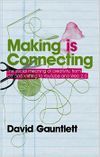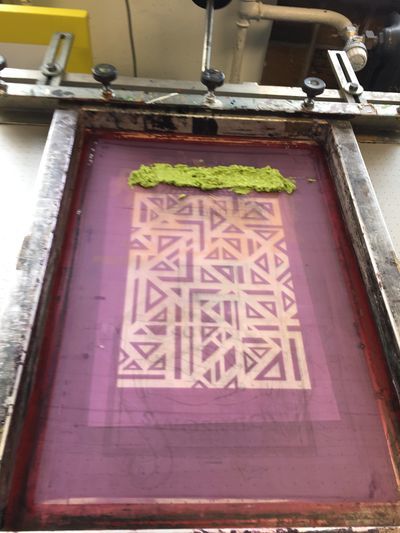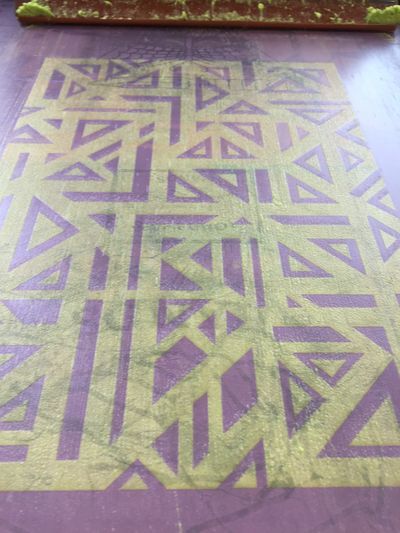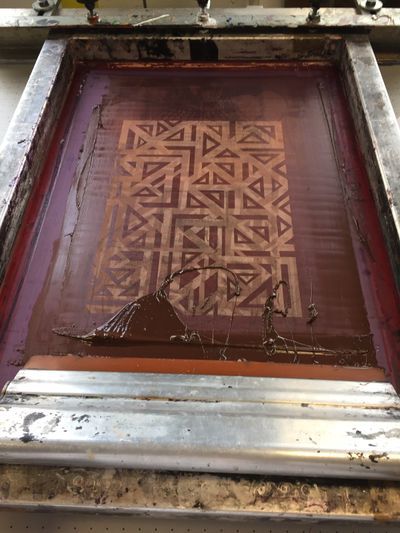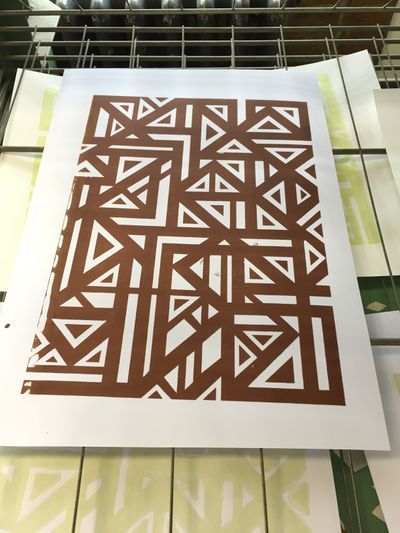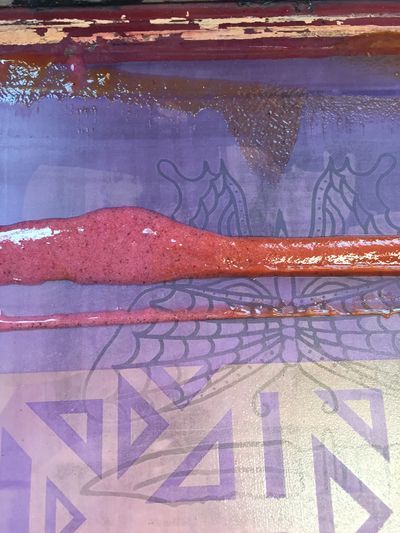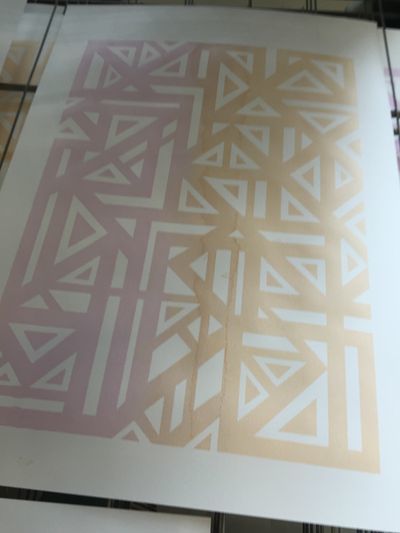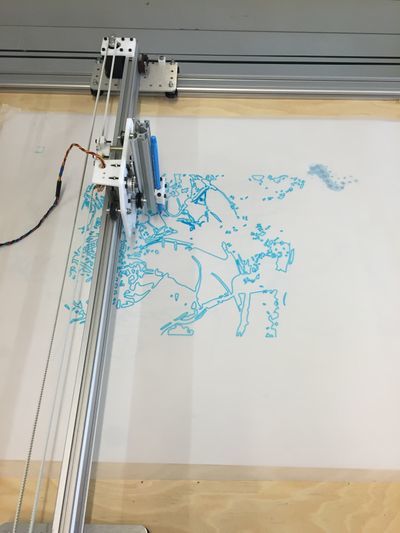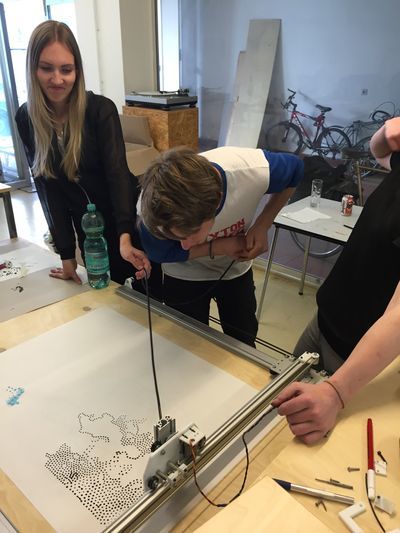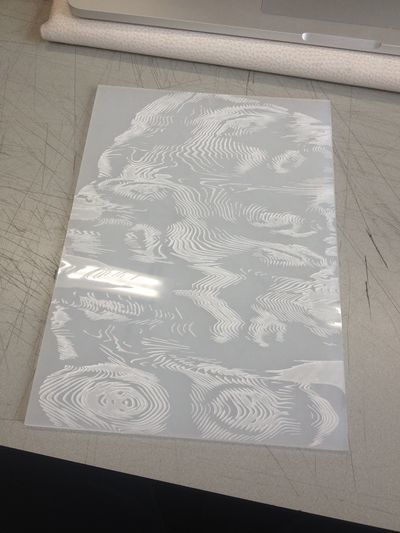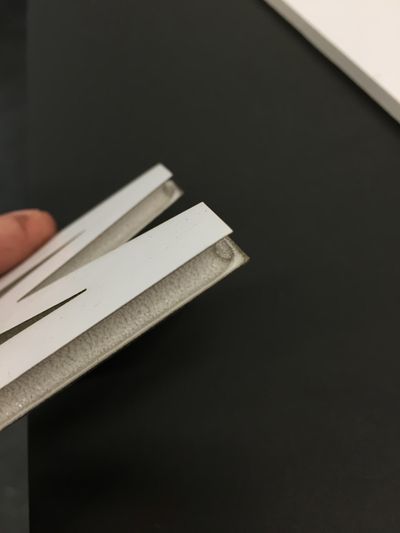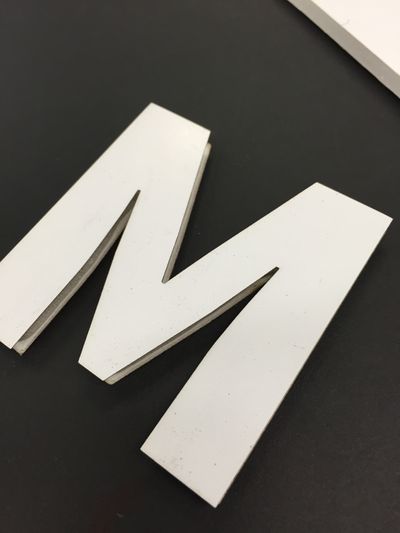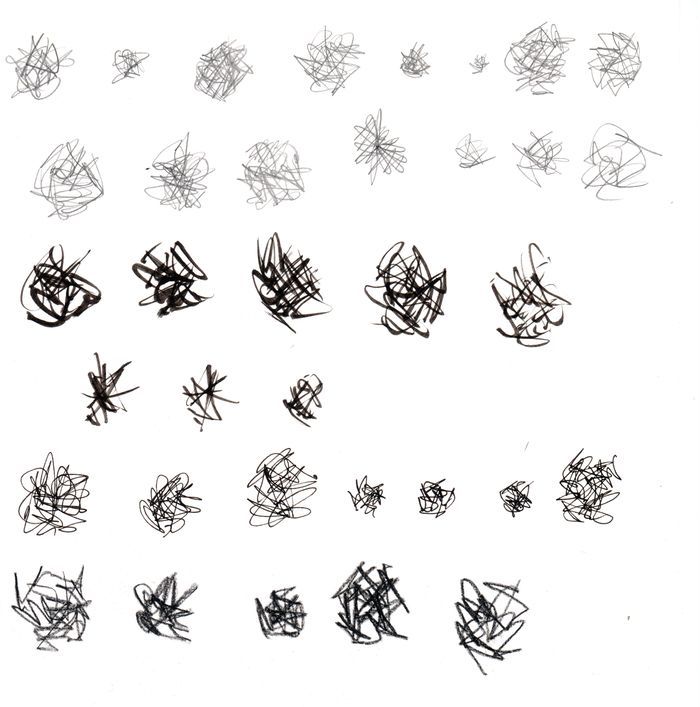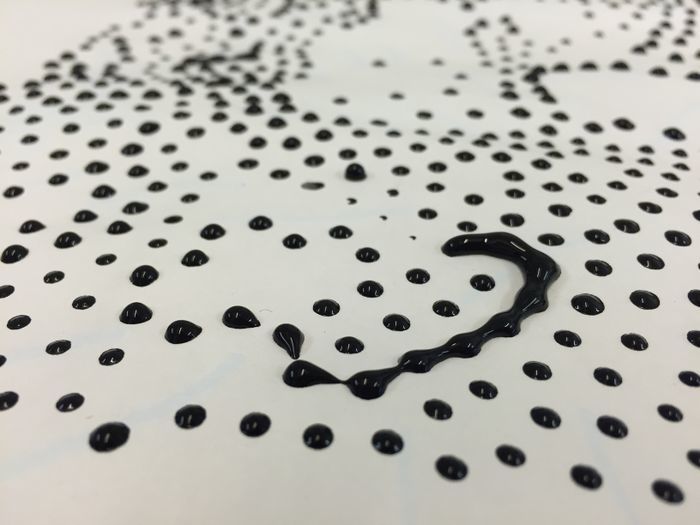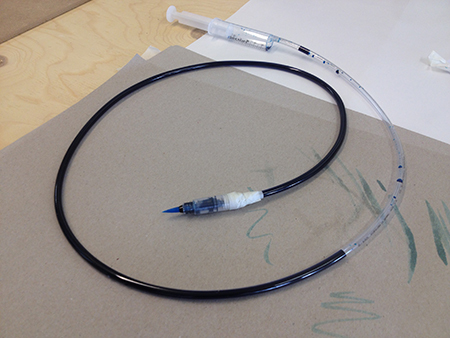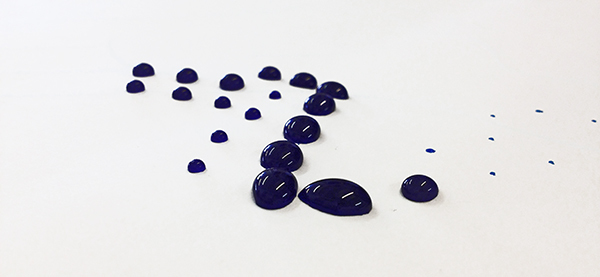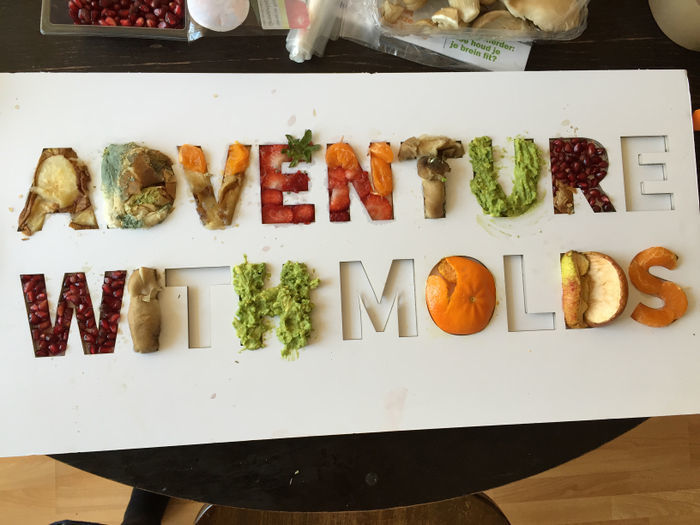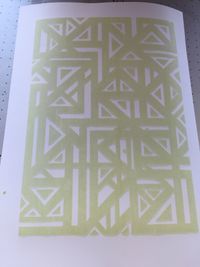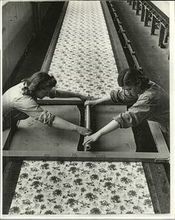User:MarjoleinStassen
Contents
MAKING IS CONNECTING
Down below are the chapters from the book 'Making is Connecting'.
UNCONTROLLABLE SUBSTANCES
I wanted to work with substances that can be used as paint, yet are also out of my control. I want to experiment how they behave and learn how I can control them. blabla intro text.
Research
Ideas
- Print with Foods.
- Uncontrollable.
- Grow fungi make it in a design.
- Generative design.
- Fruit flies (glue that smells like fruits.)
Process Photos
Results
Historical Example
As an historical example I choose the printing technique Silk Screening. Since this technique has been used in Asian long before it got to Europe to then be refined in the beginning of the 1900 by the British. Of course the one I used wasn't nearly as old as the ones the British used but I did use particular types of substances to paint with.
Comparative Example
We went to Indianen studio in Antwerpen. Under the super vision of Tim Knapen we got to work with his printing machine. We tried to push it to its limits by working together with different materials and inks. At first we drew out SVG files with a normal fineliner or marker and after that (while pushing limits) I got a great comparison of what the capabilities were of this machine. On the left is what you expect to see on a pen plotter and on the right is our own invented technique by using black acrylic mixed with water through an IV. With the pressure on the end of the cord we could create blobs instead of lines.
New Skill
To make my own artifact I decided to use a totally new technique for me. I have been wanting to use the laser cutter before but never got a project / concept that went with this technique. Now however I finally had my way with laser cutting. It was not necessarily difficult. You just need to know what the right settings are. After I set the laser cutter up I had it checked by Brigitte just to be sure. After that the laser started to cut out my lettering. I was inspired by Albert Heijn moestuintjes. Each letter is its own research process of how mold grows on certain types of food.
Collective Example & Pushing Limits
For the collaborative work we went to Indianen studio in Antwerpen. Under the super vision of Tim Knapen we got to work with his printing machine. We tried to push it to its limits by working together with different materials and inks. At first we drew out SVG files with a normal fineliner or marker. In the end Manouk made a design out of dots. We wanted to make a dotted picture with a brush pen. To get the ink through this brush without having to refill the tip we put the cord of an IV on it. At the end was a syringe to create pressure. Koen was the one that was the one that put too much pressure. Because of the extra pressure 'blobs' appeared on the paper. At first we had blue indian ink and later we continued with black acrylic mixed with water. Together we created something that even Tim was surprised and enthusiastic about!
Artifact
My Artifact is still a work in process, unfortunately my fungus and molds didn't grow quick enough for 8 weeks to fill, probably less since I started with this later in the quarter, that doesn't mean I am finished yet. I like to see my adventure is going. I am planning to go on with this sample to see of my original idea of making your design grow. The idea was to make with this 'Adventure with Molds' was to create a sample box of molds and fungi to later use in my design. I was planning on making a design with sugar water or any other bedding for my molds. To then let them grow into that design because they go wherever the food is. Now I am left with my sample box as artifact. I still haven't mastered the perfect way to grow molds fast, mainly because I am too scared to keep them in my own house.
Statement
What I have been working on so far, is trying to create a print with food. The most logical way of trying to print with food after some research was to silkscreen. When you use the screen you push the pain through it. It seemed only logical to me to continue that and press all sorts of food through the screen. I’ve tried five different kinds of food: Guacamole, Ketchup, Blueberry Smoothie, Chocolate and Vla. The guacamole and Chocolate because it is a paste based type of food and the smoothie, ketchup and vla because it has a more liquid texture.
To start Silk-screening with the food had to prepare my screen. Every type of food was purely put on the screen. Although, some needed some extra time to prepare before I could silkscreen them. With the avocado I had to mash it into a paste first, the Chocolate paste needed to be melted and then for the smoothie I’ve used ‘alles binder’ to make the texture a bit thicker. I felt it was too water-y to be used for silkscreen. If the material is too wet it will stick to my screen and ruin the print.
At first I tried silk-screening was the avocado guacamole paste, to my surprise the green paste showed beautifully on the paper. My hope for this was to capture the green turning into the brown dried out color guacamole gets hours after being made. The paper wobbled a bit because of the wetness of the guacamole paste. After drying it out, which was surprising quick, the design looked like it was made with aquarel paint. But once you feel it had a sand/grainy texture when touched. It was unlike I ever felt before.
Having my silkscreen window there anyways and having bought chocolate paste for on bread I decided that I could use the jar for silk-screening too. I got a large bowl and got hot water for tea from the cafeteria. After having the chocolate heat up and melt it turned into a more liquid-y texture. When printing I realized that chocolate cools down really quickly and gets stuck in my screen. I worked my way around it but some of the prints got stuck to my screen. What was wonderful about this type of food is that is smells delicious after being printed. The chocolate being printed (depending on the thickness) has a suede type of feeling. It is soft and nice to the touch.
The next day I went to the store again to find other materials to print with. The next thing I went to print was vla. The texture was a bit sticky when printed. The pink color of the raspberry vla didn’t show well on paper and wasn’t really interesting to work on further. I hoped that it would mold or turn a different color just like the avocado but it didn’t.
Next up was the blueberry, blackberry and raspberry smoothie. Since it was too liquid-y for me I used the ‘alles binder’ when printing it left a beautiful deep pink color that later turned more purple when drying. At the touch it is also a bit sticky to touch. After that I started to silkscreen ketchup on paper. This worked surprisingly well and left an orange color on paper. The feeling was sticky as well as the vla and smoothie. The scent of it was sour and weird smelling. Definitely not as nice as the chocolate one smelled. I also tried to mix the smoothie one with the ketchup one to see if they would have a reaction on their own.
What materials/tools/processes am I most interested in,
Every experiment has its own feeling and vibe. What I see when I look at it, is a revolutionary way of transferring food on paper. But then, what to do next? I wanted to continue with the scent but when I started thinking about it I realized I was more interested in the process of fungi and mold would start to mingle with my work. I used the avocado as a first idea to see the recoloring from green to brown after all. The other materials were just to experiment. After trying for weeks I realized what I did wrong. By silk-screening the food the screen only transferred the color of the food on paper, not the actual cells that would eventually be eaten by molds or fungi. It is a nice way to preserve food and nice knowing that when you print with food it stays in the same shape but that is not the effect I wanted to create.
For me to have less control, which was my main idea for this quarter, was what made me highly curious how to create something I didn’t necessarily have control on. For me that was using molds and fungi. Mostly molds. The idea of letting molds make the design was highly interesting to me. The design the molds would create, would become my design. I created the molds and the molds would finish my work. This process was so fascinating to me. I am not sure why I find it so fascinating but seeing your design grow from the mold and how I can control that process (being the control freak that I am). Of course you can’t master this in the mere timespan of 8 weeks but making a start into generative design seemed one logical step to make. In this I refer to my analyzing of Chapter 2 in Making is Connecting. The essential dimensions of craft: The inherit satisfaction of making - The sense of being alive within the process - The engagement of ideas, learning and knowledge which do not come before or after but within the practice of making.
Content of my work, The process I was trying to learn this quarter was due to a combination of techniques, maybe even creating a new tool for future designs and mastering a very specific process. Over all my work has one direct line to the end results I am working against. It was a natural flow to go from working and printing with food to growing mold and trying to make it in a generative design. With this I mean to generate a design by using a living structure to be able to make things grow. I am not sure what to call it other than generative. I doesn't seem to fit in Sustainable Design, Environmental Design or Conditional Design. It might be a mix of those combined. To go through this process there needs to be some mastering in certain skills. There needs to be knowledge of molds and fungi. But also what kinds of molds grow quick, ones one have a nice color or a nice texture. After these 8 weeks I am far from finishing what I am trying to accomplish. Maybe I expected too much from myself these last few weeks but I believe this gives me a certain drive to reach what I am trying to create. Growing the molds take time, patience and the right circumstances. In this I am almost a bit like William Morris. He was a man who projected a vision - a vision of great fundamental hope and optimism - through a striking number of different channels.
The broader cultural or historical context,In a way there is something really interesting about molds and fungi. They could be so dangerous that they could kill a human by only breathing in their fumes. But there is also a lighter side to the molds and fungi; “The human use of fungi for food preparation or preservation and other purposes is extensive and has a long history. Mushroom farming and mushroom gathering are large industries in many countries. The study of the historical uses and sociological impact of fungi is known as ethnomycology. Because of the capacity of this group to produce an enormous range of natural products with antimicrobial or other biological activities, many species have long been used or are being developed for industrial production of antibiotics, vitamins, and anti-cancer and cholesterol-lowering drugs.” – Wikipedia.
When making a design there might be some kind of molds or fungi you want to use while ‘growing’ your design. Maybe for a cancer research poster, the design can grow the longer it hangs outside or on a specialized bus stop window. These are just one of the possible ideas. Although we often think of fungi as organisms that cause disease and rot food, fungi are important to human life on many levels. They influence the well-being of human populations on a large scale because they are part of the nutrient cycle in ecosystems. They also have other ecosystem uses, such as pesticides. With this idea of letting mold grow your own design it can also be a nudge to the heavy history fungi have with the human race. The molding and fermenting process is extremely old, and to use that in this modern age as a way of designing gives me a sense of importance. What deeper levels can be reached while using this process for a design?
On an additional research I found out that there is a growth in bio design. Het Nieuwe Instituut had an exhibition about it, and unfortunately I missed it. A lot of press and articles talk about the effect it has on our future and our own culture. The funny thing is, is that I’ve recently read a book containing natural structures only made from nature and plants. This certain culture possessed the ability to make nature grow by singing a special song. This way they could control and structure a living tree in the form of a house without damaging it. Bio Design almost sounds like that to me.
Bio Design is becoming more talked about subject in the recent years, (2013-until now). Bio Design is in most cases about recently developed materials and applications where biological content is used for design, art and architecture. This specialized brach is a mix between science, nature and creativity. Because of the scarcity in nature humans are trying to fox their bond with nature. Not only can Bio Design be sustainable, it can also provide knowledge how to survive on the earth in the future. This last bit is what I find so inspiring about Bio Design. Even though there is a start in experiments and ideas that haven’t been produced yet, it gives you a chance to think of the impossible.
"Ontwerpers maken steeds vaker gebruik van dieren en planten om radicaal nieuwe designconcepten mogelijk te maken. (Micro-)organismen zoals schimmels, bacteriën en algen kunnen worden ingezet om textiel te maken, te veredelen of te bewerken. 'Levend' textiel dat niet mechanisch wordt vervaardigd maar is 'gegroeid’." - Textiel Commissie
There are even institutions like Waag in Amsterdam. At waag they have six labs for research and exploration, within these six labs (Creative Care lab, Creative learning lab, Future Heritage lab, Future Internet lab, Open Design lab, Open Wetlab) you are free to do artistic research. Especially the latter can be useful to have your own Bio Design Project. Along with these labs Waag also offers knowledge in specialized workshops. I’m interested in following the following courses (OpenWet Lab and Data Lab);
- http://waag.org/sites/waag/files/public/media/publicaties/bio-paper-ink.pdf
- http://waag.org/sites/waag/files/public/media/publicaties/bioprinting.pdf
- http://waag.org/sites/waag/files/public/media/publicaties/open-a-wetlab.pdf
- http://waag.org/sites/waag/files/public/media/publicaties/mystery-meat.pdf
- http://waag.org/nl/data-hunts
Thanks to institutions like Waag there is an opportunity to explore and follow courses in specialized topics, or offer the space to do your own experiments that might be too dangers to do at home, or when someone doesn’t have the equipment to do a certain experiment. With that they provide knowledge into our culture, just like Bio Design can become part of our futuristic culture.
Can this technique be used in my practice,
I believe it can even though it is a longer process to complete. It can be difficult and you need to have the patience for it. Which is also something I learned this quarter. I am always rushing from one task to another and keep thinking less and less. By trying to learn this craft I’ve learned a new way of organizing and thinking. Which I can quote from Making is Connecting once more. “Making is a part of Thinking.” What can be added to that is; one has to make time for thinking.
Why I make,
The main reason I chose to work with uncontrollable substances was because I wanted to push myself in being more flexible and less rigid. Digital Craft is a practice where you can explore and experiment to your heart’s content. I tried to use this experimenting to open my mind. Not to work with the common materials to print with. I started with silk-screening food wanting to let mold and fungi help my design process. The research into growing molds and fungi interested me a great deal. I make because I want to have an adventure in new techniques and materials and I am not done exploring yet. I believe I will never be done with exploring or having adventures.
Sources
1. http://www.citg.tudelft.nl/nl/actueel/laatste-nieuws/artikel/detail/biodesign-expositie/
